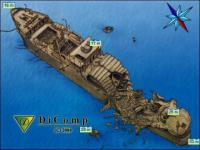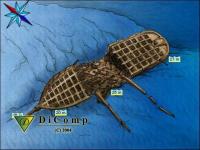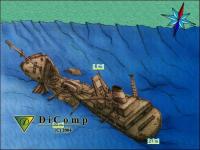|
|

Jun 13, 2006 02:00 PM Brief history of the Thistlegorm
 Location: 5 miles north from the Sinaï peninsula, 1.5 miles SE from Sha'ab Ali reef.
Location: 5 miles north from the Sinaï peninsula, 1.5 miles SE from Sha'ab Ali reef.
The Thistlegorm was launched on the 9th of April 1940. Its name means ‘blue thistle', and it was a British transport ship, 126.5 metres long with the capacity of 4,898 tons (9,009 displacement tons), and had a three cylinder steam engine developing 1,860 HP, that gave the vessel a speed of around 10 knots.
In May 1941, a crew of 39 men left on the Thistlegorm from Glasgow , with a cargo including munitions, bombs, anti-tank mines, Lee Enfield MK II rifles, BSA motorcycles, Morris and Ford trucks, tanks and even two steam locomotives. Two German bombers coming from the German airbase in Crete, sighted the Thistlegorm as it sat in the Strait of Gubal , awaiting the clearance of German mines in the Suez Canal .
They attacked the Thistlegorm. Two bombs hit the fourth hold, where the munitions deposits were situated. The resulting explosion tore the ship in two, whilst catapulting the two 126 ton locomotives, despite being tied to the deck, into the air. The crew and Captain were rescued by the HMS Carlisle, but nine men lost their lives during the attack.
The wreck was discovered by, or course, Jacques Cousteau in 1955, and later appeared in the National Geographic in 1956. Cousteau did not reveal the position of the wreck, and it went forgotten for almost 40 years until 1992 when it was rediscovered by an Israeli skipper.
The Mighty Thistlegorm is a legend amongst divers and her place will be forever enshrined in diving’s own "Great Hall of Fame." In the meantime, however, she has become a victim of her own status and is in serious decline. Sadly, none of us shall ever see this shipwreck as magnificent as she was on the day she was re-discovered - only a few short years ago. How long she will last? It is anybody’s guess!
|
Apr 27, 2006 02:00 PM The history of the Carnatic
 The Peninsula & Oriental Passenger Steamer "Carnatic" was built by Samuda Bros of London and classified as an 'iron framed planked passenger steamer of 1776 tons'. Her dimensions were 89.8m x 11.6m with a draught of 7.8m. In addition to square-rigged sails, she was powered by a single 4 cylinder compound inverted engine which produced a very handsome 2,442 hp. In September of 1869 she gently struck the reef but did not sink immediately, in fact the captain and the 210 passengers and crew spent the night on board as no one believed that a steel hulled ship, sitting gently on a coral reef, would be in too much trouble. After 36 hours on the reef though, due to the pivoting of the boat with the rise and fall of the waves causing stresses on the keel, she snapped in half with the stern sliding off the reef taking 5 passengers and 26 crew with it. The aft followed shortly afterwards and diving the wreck today you can see that the two halves have seemingly joined up again underwater. She lies on her port side in 30 meters of water. A great wreck with plenty to see including her single prop, masts, square portholes and lots of broken wine bottles in the bottom of the hold in the aft section.
The Peninsula & Oriental Passenger Steamer "Carnatic" was built by Samuda Bros of London and classified as an 'iron framed planked passenger steamer of 1776 tons'. Her dimensions were 89.8m x 11.6m with a draught of 7.8m. In addition to square-rigged sails, she was powered by a single 4 cylinder compound inverted engine which produced a very handsome 2,442 hp. In September of 1869 she gently struck the reef but did not sink immediately, in fact the captain and the 210 passengers and crew spent the night on board as no one believed that a steel hulled ship, sitting gently on a coral reef, would be in too much trouble. After 36 hours on the reef though, due to the pivoting of the boat with the rise and fall of the waves causing stresses on the keel, she snapped in half with the stern sliding off the reef taking 5 passengers and 26 crew with it. The aft followed shortly afterwards and diving the wreck today you can see that the two halves have seemingly joined up again underwater. She lies on her port side in 30 meters of water. A great wreck with plenty to see including her single prop, masts, square portholes and lots of broken wine bottles in the bottom of the hold in the aft section.
|
Apr 27, 2006 02:00 PM Another interesting wreck: The Giannis D
 Launched in 1969 as the Shoyo Maru, the Giannis D was built by the Kuryshima Dock Company of Imabari, Japan. In April 1983 on a trip to Jeddah, Saudi Arabia with a cargo of teak planks, thinking that there was nothing but the Red Sea to traverse, the captain fell asleep in his cabin after ordering 'full speed ahead'. He had, however, not reckoned on Abu Nuhas and it was not long before he was very rudely awoken by the sound of the ship being driven hard onto the north west corner of the reef. Today she is broken in 3 pieces, the bow by itself, parts of the midships with teak planks scattered around and lastly, the intact stern of the ship which really makes the dive. Full of rooms and passageways that run off at strange angles as she is lying at 45 degrees at the base of the reef. A well mangled prop marks the deepest point at 23 meters.
Launched in 1969 as the Shoyo Maru, the Giannis D was built by the Kuryshima Dock Company of Imabari, Japan. In April 1983 on a trip to Jeddah, Saudi Arabia with a cargo of teak planks, thinking that there was nothing but the Red Sea to traverse, the captain fell asleep in his cabin after ordering 'full speed ahead'. He had, however, not reckoned on Abu Nuhas and it was not long before he was very rudely awoken by the sound of the ship being driven hard onto the north west corner of the reef. Today she is broken in 3 pieces, the bow by itself, parts of the midships with teak planks scattered around and lastly, the intact stern of the ship which really makes the dive. Full of rooms and passageways that run off at strange angles as she is lying at 45 degrees at the base of the reef. A well mangled prop marks the deepest point at 23 meters.
|
|
|
|
